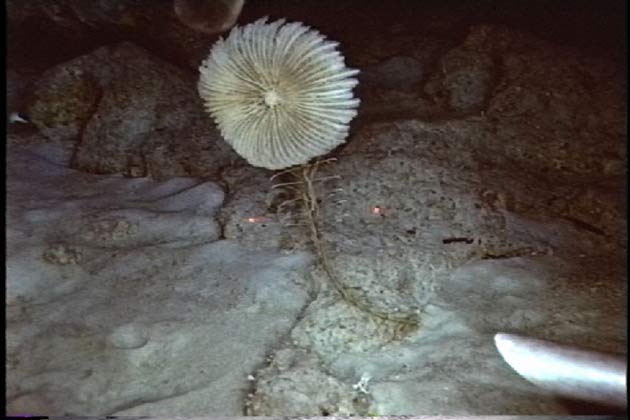Underwater Escape: A Sea Lily's Surprising Scoot

Sea lilies look like terrestrial flowers, but they are really animals. Yet until now scientists had no idea how agile they were.
A new video reveals a sea lily scooting across the ocean floor, apparently to escape a predator.
University of Michigan professor of geological sciences Tomasz Baumiller unveiled the video Sunday at a meeting of the Geological Society of America.
Get away
Sea lilies and feather stars, members of a group called crinoids, are closely related to starfish, sea cucumbers and sea urchins. The two main types of crinoids look a lot alike except that sea lilies have stalks, and feather stars do not. In addition, feather stars are known to crawl, and some can even swim, but sea lilies were thought not to have such abilities.
Some sea lilies regularly shed and regenerate the ends of their stalks, leaving finger-like appendages.
Baumiller and his colleague, Charles Messing of Nova Southeastern University, speculated that the creatures might be pulling up anchor to move to another location and the using their "fingers" to reattach.
Get the world’s most fascinating discoveries delivered straight to your inbox.
In the late 1980s the researchers observed that sea lilies could, in fact, move from place to place---Baumiller had put some in a flow tank and noticed that they changed position from day to day, and Messing had noticed the same thing during dives with a submersible off Jamaica and Grand Cayman Island. Both researchers saw sea lilies using their feathery arms to crawl, dragging their stalks behind them, but the scientists wondered what induced sea lilies to relocate in nature.
'Lizard's tail'
Then, while going through video shot during submersible dives made more than a decade ago, the researchers came across footage that showed sea urchins lurking in gardens of sea lilies, some of which appeared to be crawling away from the predators. In some photos, the sea floor around the urchins was littered with sea lily appendages, like table scraps left from a feast. What's more, the sea lilies were moving a hundred times faster than previous observations had suggested.
Further studies suggested that sea urchins don't eat bits of dead sea lilies that they find on the ocean floor but rather bite pieces right off their prey, giving sea lilies plenty of incentive to shed their stalk ends and flee.
"It's the lizard's tail strategy," said Baumiller. "The sea lily just leaves the stalk end behind. The sea urchin is preoccupied going after that, and the sea lily crawls away."
The speed at which they move---three to four centimeters per second---suggests that "in a race with a sea urchin, the sea lily would probably win."
The video can be seen here.

